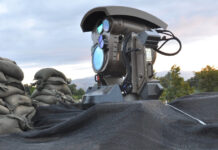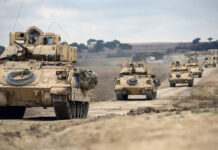Electrical power supply continues to be a major challenge to military planners, particularly when extended dismounted operations are required. New innovations introduced by several companies could offer have promissing capabilities in the future but at present, primary and rechargable batteries continue to provide the only power source to fill the militar’s thirst for power.
 General Atomics and Jadoo Power have teamed to develop power systems, replacing the heavy batteries carried by individual soldiers. The new power system is based on a fuel cell and fuel interface technology system developed by Jadoo Power, based on General Atomics’ patented ammonia borane fuel technology. In this process, the hydrogen fuel is stored in solid chemical hydride (ammonia borane). This material is decompressed to release the fuel. This material contains hydrogen twice the hydrogen volume, compared with cryogenic stored liquid hydrogen or nearly four times as compressed gaseous hydrogen (10,000 psi).
General Atomics and Jadoo Power have teamed to develop power systems, replacing the heavy batteries carried by individual soldiers. The new power system is based on a fuel cell and fuel interface technology system developed by Jadoo Power, based on General Atomics’ patented ammonia borane fuel technology. In this process, the hydrogen fuel is stored in solid chemical hydride (ammonia borane). This material is decompressed to release the fuel. This material contains hydrogen twice the hydrogen volume, compared with cryogenic stored liquid hydrogen or nearly four times as compressed gaseous hydrogen (10,000 psi).
The fuel cell is designed to be form-and-fit compatible with the BA 5590 battery pack.
The fuel is stored in a cartridge attached to the fuel cell for liquid-free processing, allowing for a rugged, reliable and portable power package. Each cartridge provides specific energy for over 750 Whr/kg. At a total weight of 10 pounds (4.5 kg) including the fuel cell and seven cartridges, the system will support a 72 mission (supplying 50 watts), replacing 21 BA 5590 batteries weighting 47 pounds (21.5 kg). Similar to a battery, this fuel cell can be instantly switched on and off, without residual ‘memory’ or self discharge effects limiting the use of similar portable power systems. In addition to the application as portable power for the dismounted soldier, these fuel cells have promising applications for unmanned systems. For example, a five lbs system could power an unmanned ground vehicle (UGV) or unmanned aerial vehicle (UAV) consuming 100 watts for 10 hours.
 Ultralife introduced the UBBL10, a new product in its “SmartCircuit” (SMBus compliant) family of batteries. This model is compatible with the popular BB-2590 format offering full compliance with the open source SMBus communications protocol. Ultralife’s SmartCircuit batteries/charger/appliance communications improves battery efficiency over its life cycle. Ultralife offers the 2590 type package in a higher capacity version, delivering 18.4Ah in 12V mode. The battery designated UBBL09 is suitable for applications that previously used nickel-metal hydride type cells.
Ultralife introduced the UBBL10, a new product in its “SmartCircuit” (SMBus compliant) family of batteries. This model is compatible with the popular BB-2590 format offering full compliance with the open source SMBus communications protocol. Ultralife’s SmartCircuit batteries/charger/appliance communications improves battery efficiency over its life cycle. Ultralife offers the 2590 type package in a higher capacity version, delivering 18.4Ah in 12V mode. The battery designated UBBL09 is suitable for applications that previously used nickel-metal hydride type cells.

Vehicle lights are a known power consumer in all types of vehicles. Combat vehicles, placed on silent guard for many hours are subject to severe light saving restrictions, especially white light. In addition to the power consumption penalty, white light are also damaging night visibility and may disorientate observers. It is also susceptible of being spotted by image intensifiers. Blue or red lights are more ‘friendly’ in such environment. Eltam, an Israeli company specialized in lighting technologies developed a LED lighting system specifically adapted for combat vehicles.
Eltam lights are currently being used in Israeli Merkava tanks, and were also installed in a number of US combat vehicles. At AUSA Eltam lights could be seen on a wide range of vehicles, including the Paladin, Bradley technology demonstrator and Paladin. Produced in in red/white or blue/white combinations, Eltam’s dimmable lights contribute to significant saving in power. A by-product is the ability to indicate low battery state, alarming the crew of an imminent battery drain, enabling the crew to start the engine for timely recharge.



















